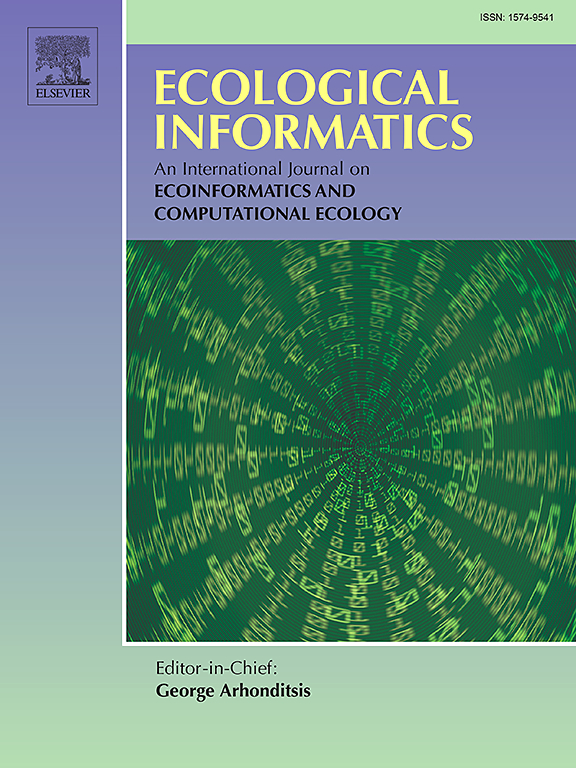How to minimize the annotation effort in aerial wildlife surveys
IF 7.3
2区 环境科学与生态学
Q1 ECOLOGY
引用次数: 0
Abstract
Aircraft-based monitoring of wildlife is a popular way among conservation practitioners to obtain animal population counts over large areas. Nowadays, these aerial censuses are becoming increasingly scalable due to the advent of drone technology, which is frequently combined with deep learning-based image recognition. Yet, the annotation burden associated with training deep learning architectures remains a problem especially for commonly used bounding box detection models. Point-based density estimation- and localization models are cheaper to train, and often work better when the aerial imagery is recorded at an oblique angle. Beyond this, though, there currently is little consensus about which strategy to use for what kind of data. In this work, we address this knowledge gap and evaluate modifications to a state-of-the-art detection model (YOLOv8) that minimize labeling efforts by enabling it to work on point-annotated images. We study the effect of these adjustments on detection accuracy and extensively compare them to a localization architecture on four datasets consisting of nadir and oblique images. The goal of this paper is to offer wildlife conservationists practical advice on which of the recently proposed deep learning architectures to use given the properties of their images, as well as on the data properties that will maximize model performance independently of the architecture. We find that counting accuracy can largely be maintained at reduced annotation effort, that object detection technology outperforms the localization approach on nadir images, and that it shows competitive performance in the oblique setting. The images used to obtain the results presented in this paper can be found on Zenodo for all publicly available datasets, as well as all code necessary to reproduce our results was uploaded to GitHub.
如何减少空中野生动物调查的注释工作量
以飞机为基础的野生动物监测是保护工作者获取大面积动物种群数量的一种流行方式。如今,由于无人机技术的出现,这些空中普查变得越来越可扩展,无人机技术经常与基于深度学习的图像识别相结合。然而,与训练深度学习架构相关的注释负担仍然是一个问题,特别是对于常用的边界盒检测模型。基于点的密度估计和定位模型的训练成本更低,而且当航空图像以倾斜角度记录时通常效果更好。除此之外,目前对于使用哪种策略来处理哪种类型的数据几乎没有共识。在这项工作中,我们解决了这一知识差距,并评估了对最先进的检测模型(YOLOv8)的修改,该模型通过使其能够在点注释图像上工作来最大限度地减少标记工作。我们研究了这些调整对检测精度的影响,并将其与由最低点和倾斜图像组成的四个数据集的定位体系结构进行了广泛的比较。本文的目标是为野生动物保护主义者提供实用的建议,告诉他们在给定图像属性的情况下,应该使用哪种最近提出的深度学习架构,以及将独立于架构的模型性能最大化的数据属性。我们发现,在减少标注工作量的情况下,计数精度可以在很大程度上保持不变,目标检测技术在最低点图像上优于定位方法,并且在倾斜设置中表现出竞争力。在Zenodo上可以找到所有公开可用的数据集,用于获得本文中提供的结果的图像,以及复制我们的结果所需的所有代码都被上传到GitHub。
本文章由计算机程序翻译,如有差异,请以英文原文为准。
求助全文
约1分钟内获得全文
求助全文
来源期刊

Ecological Informatics
环境科学-生态学
CiteScore
8.30
自引率
11.80%
发文量
346
审稿时长
46 days
期刊介绍:
The journal Ecological Informatics is devoted to the publication of high quality, peer-reviewed articles on all aspects of computational ecology, data science and biogeography. The scope of the journal takes into account the data-intensive nature of ecology, the growing capacity of information technology to access, harness and leverage complex data as well as the critical need for informing sustainable management in view of global environmental and climate change.
The nature of the journal is interdisciplinary at the crossover between ecology and informatics. It focuses on novel concepts and techniques for image- and genome-based monitoring and interpretation, sensor- and multimedia-based data acquisition, internet-based data archiving and sharing, data assimilation, modelling and prediction of ecological data.
 求助内容:
求助内容: 应助结果提醒方式:
应助结果提醒方式:


